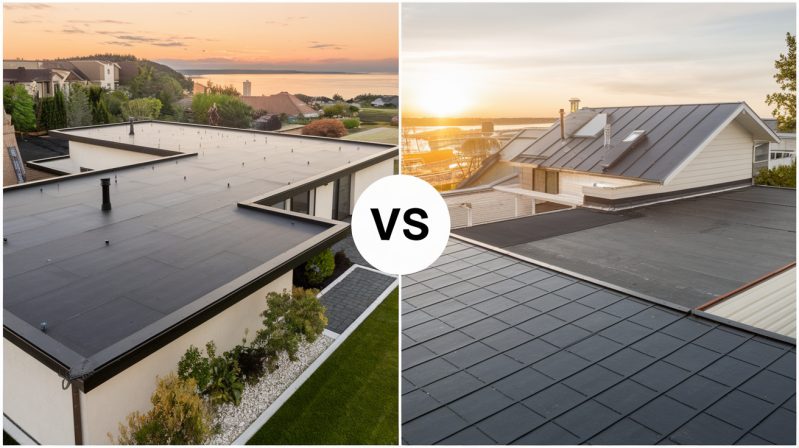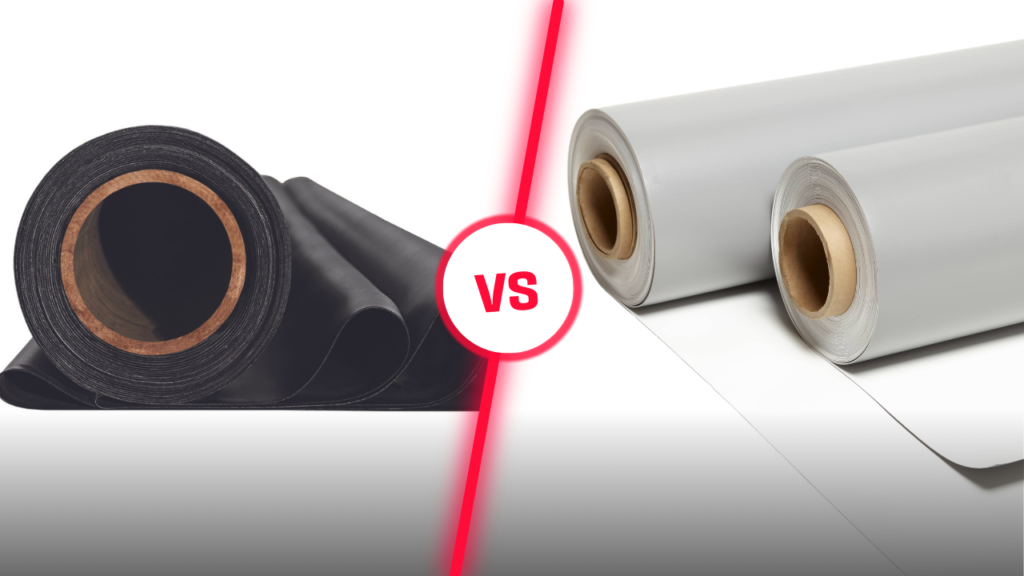Choosing the right material for your commercial roofing project is a critical decision that impacts everything from your energy bills to the longevity of your investment. In the world of flat and low-slope roofing, two materials dominate the market: Thermoplastic Polyolefin (TPO) and Ethylene Propylene Diene Monomer (EPDM). Both are single-ply membranes, but they have distinct differences that make one a better choice than the other depending on your specific needs. So, is TPO better than EPDM? The answer is nuanced, and it depends on what you value most.
The Contenders: TPO vs. EPDM
To understand which material is right for your commercial roofing project, you need to break down their characteristics.
TPO (Thermoplastic Polyolefin)
TPO is a newer commercial roofing technology, gaining immense popularity over the last two decades. It’s a single-ply, heat-weldable membrane made from a blend of polypropylene and ethylene-propylene rubber. The key feature of TPO is its ability to be heat-welded at the seams. This process melts the membrane together, creating a seamless, waterproof bond that is stronger than adhesive or tape-based seams. This is a significant advantage in preventing leaks, which are a common point of failure in any roofing system.
EPDM (Ethylene Propylene Diene Monomer)
EPDM, often referred to as “rubber commercial roofing,” has been a trusted commercial roofing material for over 50 years. It’s a durable, synthetic rubber membrane that is known for its incredible longevity and resilience. EPDM comes in large rolls and is typically installed using adhesives or mechanical fasteners. The seams are then sealed with tape or liquid adhesive. While EPDM has a proven track record, the seams are its primary weakness, as they can fail over time.

Key Comparison Points: TPO vs. EPDM
1. Cost
In most cases, TPO is the more cost-effective option for upfront installation. According to industry data, TPO can cost between $5 and $12 per square foot, including materials and labor. EPDM is often slightly more expensive, particularly when using a fully adhered system. However, the overall cost can fluctuate based on factors like material thickness, installation method, and the complexity of your roof.
2. Longevity and Durability
This is a category where both materials have strong arguments. EPDM has a long, proven track record. Many EPDM roofs installed decades ago are still performing well, with some systems lasting up to 50 years with proper maintenance. It’s highly resistant to extreme temperatures, UV radiation, and general weathering.
TPO is a newer product, so its long-term performance is still being tracked. However, modern TPO membranes are designed to last for 20 to 30 years. TPO has excellent resistance to tears, punctures, and mold growth. Its heat-welded seams are generally more durable than EPDM’s adhesive seams, which is a major factor in its long-term performance.
3. Energy Efficiency
When it comes to energy efficiency, TPO has a clear advantage. TPO membranes are most commonly available in white, which is a highly reflective surface. This “cool roof” technology reflects up to 80% of the sun’s UV rays, preventing heat from penetrating the building. This can lead to a significant reduction in air conditioning costs—up to 15-25% in some cases, especially in a hot climate like Orlando. This also helps combat the “urban heat island effect.”
While EPDM is also available in white, its standard black color absorbs a lot of heat, which can drive up cooling costs. However, in colder climates, a black EPDM roof can be beneficial, as it helps absorb solar heat and reduce heating costs. EPDM’s emissivity (its ability to radiate heat away) is also high, allowing a building to cool off faster at night.
4. Installation
Both TPO and EPDM are relatively easy to install, but their methods are different. EPDM installation is less equipment-intensive, as it primarily relies on adhesives or mechanical fasteners. This can make it a faster installation process. However, the quality of the seams is entirely dependent on the adhesive and the installer’s skill.
TPO installation requires a hot-air welder to create the heat-welded seams. This requires specialized equipment and trained professionals, but it results in a stronger, more reliable seam. The installation must be done on a dry day, as moisture can affect the weld’s integrity.
5. Environmental Impact
Both materials have their environmental benefits. TPO is often lauded for being a “green” option because its reflective surface reduces energy consumption. It is also recyclable at the end of its lifespan.
EPDM is also considered environmentally friendly due to its long lifespan, which means fewer replacements and less waste. EPDM is a chemically inert material and can be recycled into other products. It’s also suitable for use with green roofs and rainwater harvesting systems.
The Verdict: Which is Better for Your Orlando Commercial Roofing Project?
So, back to the original question: Is TPO better than EPDM? The short answer for most commercial properties in Orlando is yes, TPO is often the superior choice.
Here’s why:
- Energy Savings: Orlando’s hot climate makes TPO’s reflective “cool roof” properties a game-changer. The long-term energy savings on your air conditioning bill can easily outweigh any difference in initial installation cost.
- Seam Integrity: The heat-welded seams of TPO offer a superior, more durable, and more reliable defense against leaks compared to the adhesive-based seams of EPDM. Given Florida’s heavy rainfall and intense storms, this is a huge advantage.
- Puncture and Tear Resistance: TPO generally offers better resistance to punctures and tears, which is important for commercial roofs that may have foot traffic for maintenance or rooftop equipment.
While EPDM is a fantastic, time-tested material with an impressive lifespan, its black color and less-durable seams make it a less ideal choice for the specific climate and needs of Central Florida.
Ultimately, the best choice for your commercial building is the one that aligns with your budget, environmental goals, and long-term performance expectations. Both TPO and EPDM are excellent materials when installed correctly by a professional.
If you’re considering a new commercial roof or need to repair an existing one, it’s essential to consult with an experienced and reputable commercial roofing contractor. They can assess your property’s unique needs and recommend the best solution for you.
Call us for a free, no-obligation commercial roofing estimation. We are here to help you through every step of the process!




